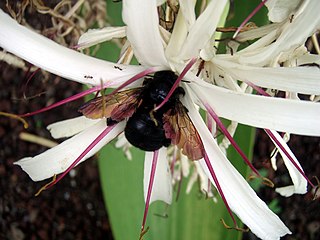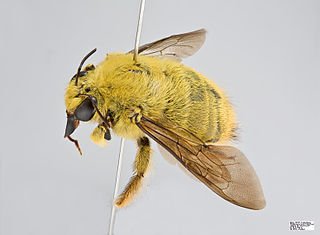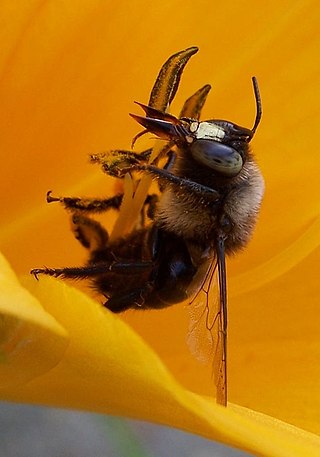
Apidae is the largest family within the superfamily Apoidea, containing at least 5700 species of bees. The family includes some of the most commonly seen bees, including bumblebees and honey bees, but also includes stingless bees, carpenter bees, orchid bees, cuckoo bees, and a number of other less widely known groups. Many are valuable pollinators in natural habitats and for agricultural crops.

Carpenter bees are species in the genus Xylocopa of the subfamily Xylocopinae. The genus includes some 500 bees in 31 subgenera. The common name "carpenter bee" derives from their nesting behavior; nearly all species burrow into hard plant material such as dead wood or bamboo. The main exceptions are species in the subgenus Proxylocopa, which dig nesting tunnels in suitable soil.

Xylocopa violacea, the violet carpenter bee, is the common European species of carpenter bee, and one of the largest bees in Europe. It is also native to Asia.

Xylocopa sonorina, the valley carpenter bee or Hawaiian carpenter bee, is a species of carpenter bee found from western Texas to northern California, and the eastern Pacific islands. Females are black while males are golden-brown with green eyes.

The California carpenter bee or Western carpenter bee, Xylocopa californica, is a species of carpenter bee in the order Hymenoptera, and it is native to western North America.

Xylocopa caffra is a species of Afrotropical carpenter bee that ranges from west to central and southern Africa, besides Madagascar and some Indian Ocean archipelagos.

Xylocopa caerulea, the blue carpenter bee, is a species of carpenter bee.

The Oriental carpenter bee, Xylocopa nasalis, or Xylocopa (Biluna) nasalis, is a species of carpenter bee. It is widely distributed in Southeast Asian countries. It is a major pollinator within its ecosystem, and is often mistaken for a bumblebee. The species leads a solitary lifestyle with a highly female-biased colony in the nest.

Xylocopa inconstans is a species of carpenter bee.

Xylocopa micans, also known as the southern carpenter bee, is a species of bee within Xylocopa, the genus of carpenter bees. The southern carpenter bee can be found mainly in the coastal and gulf regions of the southeastern United States, as well as Mexico and Guatemala. Like all Xylocopa bees, X. micans bees excavate nests in woody plant material. However, unlike its sympatric species Xylocopa virginica, X. micans has not been found to construct nest galleries in structural timbers of building, making it less of an economic nuisance to humans. Carpenter bees have a wide range of mating strategies between different species. The southern carpenter bee exhibits a polymorphic mating strategy, with its preferred method of mating changing as the season progresses from early spring to mid summer. Like most bees in its genus, the southern carpenter bee is considered a solitary bee because it does not live in colonies.

Triepeolus kathrynae is a species of cuckoo bee in the family Apidae. It is found in the United States and Mexico.

Ceratina cobaltina is a species of small carpenter bee in the family Apidae. It is found in Central America.

Epeolus pusillus is a species of cuckoo bee in the family Apidae. It is found in the United States and Mexico. The species is a parasite of Colletes compactus and Colletes ciliatoides.

Triepeolus verbesinae is a species of cuckoo bee in the family Apidae. It is found in the United States and Mexico.
Triepeolus loomisorum is a species of cuckoo bee in the family Apidae. It is found in the United States and Mexico.

Triepeolus remigatus is a species of cuckoo bee in the family Apidae. It is found in the United States and Mexico.

Xylocopa mexicanorum is a species of carpenter bee in the family Apidae. It is found in Central America and North America.

Xylocopa tabaniformis, the horsefly-like carpenter bee or mountain carpenter bee is a species of carpenter bee in the family Apidae. It is found in Central America, North America, and South America. It is 12–18 millimetres long and black. Males have yellow hair on the thorax.
Ceratina dallatorreana is a species of small carpenter bee in the family Apidae. It is found in Africa, Europe and Northern Asia, and North America.

Ceratina dupla, the doubled ceratina, is a species of small carpenter bee in the family Apidae. It is found in the eastern half of North America. It was formerly confused with the species Ceratina floridana and Ceratina mikmaqi, until molecular analyses demonstrated significant genetic differences between the taxa.



















